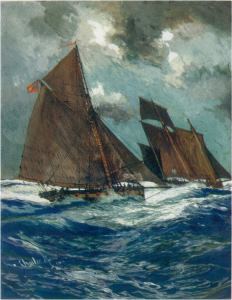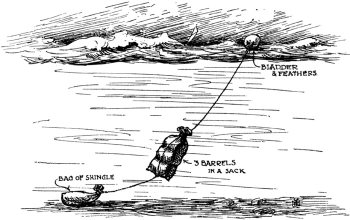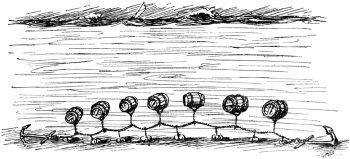Smugglers
A large
percentage of the population was involved in smuggling
either directly or indirectly which may well have
involved your ancestors although of course it probably
won't be written down anywhere .
The items
smuggled were those which were taxed in England - silk
clothing, tobacco, tea and alcohol mainly brandy and
geneva (now known as gin)
The first Essex
smugglers smuggled wool into Europe to take advantage of
the high taxes then levied on wool in the Continent.
Economics of the sea trade meant that they made even
more profit if they brought a cargo back to Essex and an
even larger profit if it was liable for tax in England.
The golden period
for smuggling was from 1730 to 1830 when smugglers
pitted their wits against the Revenue men. The trade was
so frequent that the Customs employed two cutters manned
by up to 30 men as well as riders who patrolled the
coast on horseback.
Herbert W
Tompkins writes of the local smugglers in his 1904 book
' Marsh Country Rambles' Examine a large map of Essex
and you will see how truly the county was made for
smugglers. Run you eye along the marvelously contorted
coastline from Shoeburyness to St Osyth Point. There are
at least 50 well defined rivers, creeks or outfalls; to
search the coast for some notorious gang on a dark night
was like looking for the proverbial needle in a
haystack. What artificial deep ways cut into cliffs were
to the Cornish men the sea wall was to the Essex
smuggler. Both afforded excellent shelter when goods-
whether kegs, bales or what not were being stealthily
conveyed up country. The Preventive Officer could see
nothing unless actually on the wall in which case if
there was enough light to serve his purpose it also
served to render him a conspicuous mark for a bullet. A
revenue cutter pursuing a small smuggling craft along
one of the winding creeks in the neighbourhood of the
Blackwater could see nothing of what was going forward
on land where even the country gentleman was in league
with the smugglers often sending ponies to the appointed
landing place to bear the kegs posthaste many miles
inland.
Such was the
profit that smugglers normally outnumbered the Revenue
Men and were prepared to battle to protect their cargo
and prevent capture.
Some brave
smugglers sailed in heavily armed vessels prepared to
fight if they met with the customs men although most of
the smuggling used the increasing local coastal traffic
with barges laden with coal , timber and stone on their
journey into our ports and then oysters, corn and other
farming products on their way out. Whilst the port at
Burnham on Crouch could take larger coastal vessels the
many sailing barges used small quiet jetties at
Althorne, Creeksea, Bradwell and Mayland Creek well away
from prying eyes. These cargoes and regular trips made
great cover to hide an illicit cargo loaded from a
French ship out of sight of the land and watching riding
men of the revenue service.
The poor living
conditions of the time meant that local residents saw
and heard nothing as long as the occasional pitcher of
brandy was occasionally left near to their dwelling.
Reminders still
exist such as Brandy Bridge at Tillingham and Brandy
Hole on the River Couch and rumour has it that Asheldham
Wood still contains hidden Geneva left from the
smugglers heyday.
Many of the ghost
stories have their origins in smugglers activity when it
was in the interest of smugglers to speread stories
about haunted places at some of the isolated locations
that they favoured.
One of the
favourite smugglers locations was St Peters Chapel at
Bradwell which provided both lookout post and temporary
weatherproof store for goods in the remote area of
marshes to which only locals knew safe routes.
The area around
St Peters Chapel is also subject of many ghost stories.
How many had
their basis on the grounds of carts with muffled wheels
and horses with cloth on their hooves giving a ghostly
sound as they passed.
Smugglers used a
system of lantern signals for communication. Different
movements and different times of exposure had different
meanings within each gang.
A watcher on
Beacon Hill at St Lawrence had good vision of movements
on the Shore and the River and an exposed light could be
seen for miles in each direction and on the opposite
side of the River.
These signals
were repeated across the Dengie providing plenty of
warning of the arrival of any Revenue Men on foot and
allowing plenty of time to sink any contraband should a
Revenue Cutter approach on the river.
J Wentworth Day talks about Dengie smugglers in his book - Marshland Adventures "Death Creek at the seaward end of Osea Island, we may be sure was a very citadel of smuggled stuff. Indeed just across the water , at Stansgate Abbey, some carts full of contraband were seized as they were being driven across the marsh, and escorted through the village by a guard of Excise men with drawn cutlasses .One of the drivers who escaped hid in the straw. The Excise men , true to form, jabbed their cutlasses into the straw but equally true to form, failed to spike him"
.Many smugglers
such as the Bradwell Parish Constable Hezehiah Staines
delighted in carrying out smuggling activities himself
and being paid by the Excise men for information and
assistance.
Raven of Steeple
used to boast that he could run more kegs of holland and
travel more speedily that any other man in his parish.
|
|
|
|
Illustrations of the two commonest ways for
smugglers to leave contraband off the coast
for collection later |
|
The
best known smuggling family to use the Crouch were the
Dowsett's which saw the notorious William Dowsett
establish a reputation as untouchable.
William's brother John Dowsett operated the Big Jane which
carried six brass six-pounders and was involved with
several battles with Revenue cutters in the Crouch until
it was taken in 1780 after an 11 hour chase with the
Revenue Cutters Bee and Argus.
The
Dowsett's were so well known that they were often used
by travelers to travel from France to England. John
Harriot of Stambridge ( Later to form the London River
Police) wanted a passage home and came to an arrangement
with the smugglers. At dinner before the trip he was
invited to join in the toast 'Damnation to all Revenue
laws and officers' Harriot was a MP and protested,
pointing out that the abolition of the revenue laws
would mean the end of smuggling and which the toast was
amended to 'Revenue Laws and Officers for ever'.
William Dowsetts
dominance ended in 1778 when the Revenue cutter Bee
chased a forty ton cutter called Neptune, commanded
by William Dowsett, from the Crouch until she
grounded on the Barrow Sand. The Neptune was damaged by
gunfire from the Bee until her crew abandoned ship and
the Neptune was found to contain 391 half
ankers(four gallons of spirits), two wholes of brandy,
rum and geneva, 8cwt tea and 3 cwt coffee.3 weeks later
the Revenue cutter Bee captured another 40 ton cutter Waggon commanded
by Dowsett.

a painting by
renowned naval painter Charles Dixon showing a Customs
Cruiser chasing a smugglers lugger
In December 1794
a cutter called the Ox from Rowhedge was found in the
act of lowering her contraband by a cutter from the
Bradwell Revenue Cutter, The Fly. The Ox made a run for
it but was captured and 342 barrels of Brandy and Geneva
was recovered.
From 1810 to 1890
The Customs posted a watch vessel to the Crouch to act
as a base and a home for the Customs men. The Ruswarp was
the first boat, then the Chanticleer and finally
the Kangaroo. The boat was sited on a sport near
to the present Royal Corinthian Yacht Club.
Watch vessels
were also active in the River Blackwater at Bradwell on
Sea although they appeared to be operationally used.
From 1810 to
about 1860 they were the Rattlesnake, Richmond and
the Whitworth. Coastguard's and their families
lived in a row of cottages in the Waterside area of
Bradwell on sea. To this day the cottages are known as
Coastguard Cottages.
In 1805 the 53
ton cutter Fox ,crewed by 17 men under the
command of Matthew Hoare, was based at Bradwell on Sea
covering the coat from Gravesend to Harwich.
Enforcement
against smugglers was not a co-ordinated operation
until, 1822 when the Preventative Water Guard were
formed under one command. This group organised patrols
by boat and foot and came to be known by a name that we
recognise now of HM Coastguard. The efforts of the new
Coastguard's proved the death knell for large scale
smuggling although of course it has continued to
flourish to this day.
In 1854 one of
the last ' old style' smuggling confrontation took place
off Eastlands at Bradwell on Sea .A lugger arrived from
Holland packed with kegs of spirits and tobacco arrived
to unload it's contraband only to be approached by three
Customs cutters from the new Coastguard Service. The
alert skipper jettisoned the cargo before the Coastguard
arrival and a search proved negative. Two of the cutters
left but a third searched the area with grappling irons
and recovered the contraband. The result was that the
lugger and crew were taken to Gravesend where the
Captain was fined the large sum of £100 and the tobacco
burned in Her Majesty's pipe
In June 1870
James McDonald was Chief Officer of Coastguard's at
Bradwell on Sea while John Green was in charge at
Burnham on Crouch until 1879 when he moved to Yarmouth
and was replaced by John Brand.
Rudyard Kipling captured the
local feelings towards smuggling in his poem - A
smugglers song
If you wake at midnight and hear
a horse's feet
Don't go drawing back the blinds
or looking in the street
Them that asks no questions
isn't told a lie
Watch the wall, my darling,
while the gentlemen go by
Five and twenty ponies ,trotting
through the dark
Brandy for the Parson, Baccy for
the Clerk
Laces for a lady: letters for a
spy
And watch the wall my darling, while the gentlemen go
by.






